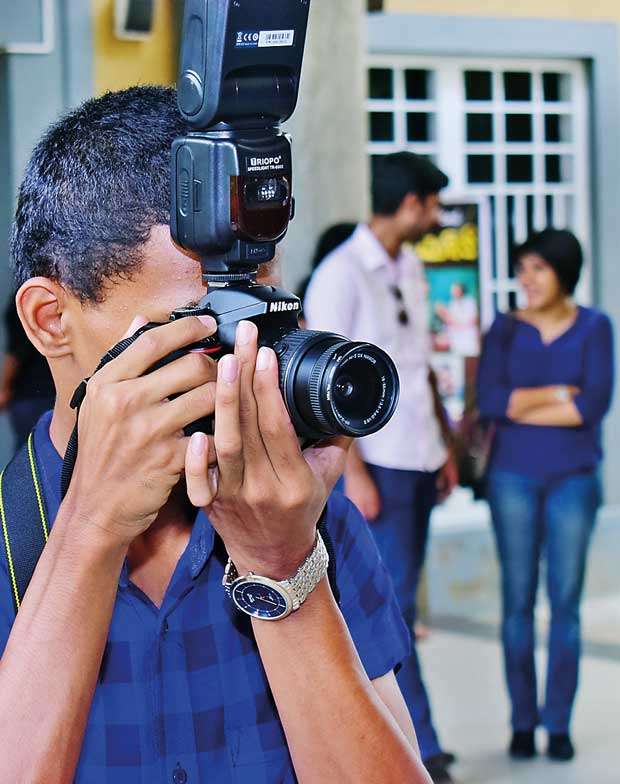Reply To:
Name - Reply Comment
Last Updated : 2024-04-19 14:00:00

For a long time I’ve been dreaming of a photo exhibition spanning the length and breadth of Sri Lanka. Such an exhibition would necessarily cost a lot, in particular  since it would cover a whole range of themes and subject matter including, but not limited to, the art forms in this country, from dance to theatre to music and even to that most Western of all objects d’art, film. Still, it would be a worthwhile enterprise, especially if it’s taken beyond the confines of Lionel Wendt and Barefoot and into areas less covered by photographers and exhibitions, and it would do much to educate the people, most significantly the young, of the shapes, sights, and scenes which have coloured this country. There can even be competitions organised.
since it would cover a whole range of themes and subject matter including, but not limited to, the art forms in this country, from dance to theatre to music and even to that most Western of all objects d’art, film. Still, it would be a worthwhile enterprise, especially if it’s taken beyond the confines of Lionel Wendt and Barefoot and into areas less covered by photographers and exhibitions, and it would do much to educate the people, most significantly the young, of the shapes, sights, and scenes which have coloured this country. There can even be competitions organised.
Photography is an intricate craft. Some of the most ardent lovers of this country, whom I have had the fortune of meeting, are (or have been) photographers. It cannot be a coincidence. There is Tharindu Amunugama. There is Hiranya Malwatta. There is Lakshman Nadaraja. There is Dominic Sansoni. There is Henry Rajakaruna. There is my good friend, Tharosa Rajaratne, who is yet to emerge and who still uses those old roll film cameras. And towering over all of them, there is the late Nihal Fernando.

Whether through a camera or a phone, they have captured the beauty of this island in ways that no self-labelled patriot or populist has. They have rendered a service. They still are rendering a service. Isn’t it time we thought about their contribution, and the contribution of their craft towards this tiny, battered, and yet resplendent island?
To be sure, photography costs a lot. Given the right circumstances, it pays a lot too. For a long time, however, it was and is considered the preserve of the wealthy. There is some truth to this view. If you don’t have the bucks to spend, if you don’t have the luxury of time, photography automatically becomes a way of earning those bucks and that luxury. That is why we have event photographers mushrooming every month or so on social media. That is why even landscape photographers have to resort once in a while to commercial photography. Especially advertising. This is true of a great many art forms. To give just one example, somewhere in the early nineties Lester James Peries earned from an hour-long shoot for a commercial the entire salary that had been paid to him for directing a whole film: Yuganthaya.
As such, the deterioration of this largely technology-driven art into a plastic enterprise bothers me, though it bothers me less than the indifference of the young towards the aesthetics which govern that art. For a great many people I have met, and talked to, photography involves tapping into a particular feature on their DLSRs, fixing a flash, and going on clicking, clicking, clicking. Despite the profusion of courses dedicated to the field cropping up everywhere, it has become as debased as those other art forms which have suffered the brunt of commercialisation. Like music.

Why does this disturb me? Simply because the generation of Nihal Fernando seems to be going extinct. Hiranya Malwatta takes amazing pictures of our cultural sites, but how many share her enthusiasm for the history of those sites? It cannot be that the art no longer inspires practitioners of the craft. And it cannot be that commercialisation is to blame. Someone told a friend of mine that “Creativity pierces through plastic.” In that respect, isn’t it futile to denigrate the deterioration of an entire art on the basis of how it has been debased by commerce? What about those “veterans” I referred to and mentioned before? Didn’t they dabble in commercial photography too?
Around a decade or so ago, there were very few photographers. Fewer professional photographers. Taking pictures was expensive. A person earning 15,000 rupees a month would have to spend a cool third of his salary on developing those pictures. Added to that was the cost of roll films, flashes, and tripods.
Then the great digital revolution transpired. Brands like Sony began marketing compact cameras to the dilettante. Before long, smartphones began tapping into the market. All this fermented a “renaissance” in the art. In 2004, 18.85 million cameras were sold globally, an increase of 28 percent over the previous year. The biggest sellers were and continued to be digital cameras. It was a trend which would survive the recession, a trend which today has more or less become saturated (in 2010, digital camera sales reached 120 million units, a figure that has dropped drastically because of, among other reasons, a diminishing rate of innovation). Not that it was all beds and roses, of course: Kodak, for instance, had to file for bankruptcy after its belated and failed attempts at adapting to the new world. Still, it was an exciting world.
My point is that before sales picked up, before the market began to saturate, there weren’t a great many professional practitioners in the field. The result was that we looked forward to the occasional exhibition, the infrequent coffee table book, with unflinching, unconditional enthusiasm. Now we have become indifferent to that exhibition and coffee table book. Not because, to paraphrase a Sinhala saying, cameras have become to photographers what knives are to monkeys, but because quantity has outstripped quality to such an extent that there is a rift between the number of photographers and their knowledge of the aesthetics and the etiquette surrounding what they practise.
The field that has suffered the most is landscape photography. Sure, the Tourist Board and other organisations have made it possible for landscape photographers to flourish. There still are books published on the Dalada Perahera and places like Sri Pada. It is a field that requires tremendous reserves of patience, dedication, care, and love. Not everyone harbours that kind of dedication. And not everyone has the time. Especially not the young. It is a paradox at one level, but even with this dilemma, school level photography has never been more popular than it is now. Clubs are springing up, making use of entry level if not intermediate level Nikons and Canons like never before. Events are being covered and photos taken at those events are being turned into veritable works of art. Exhibitions organised by budding practitioners, including, most prominently perhaps, Pilibimbu (by the Photographic Art Society at Ananda College), are seen every other month in and around Colombo. They display a deep perceptiveness, awareness, and appreciation of photography as a felt art, never for once limited to commercial events. Despite that, there is a problem. It is a problem that has escaped the notice of writers and experts (self-appointed or otherwise) on the subject.
Back when the likes of Lal Hegoda practised and/or wrote on their field, photography was never an art limited to “form”. The aesthetics governing it was always born out of experience. Actual, tangible experience. Sumitra Peries, who dabbled in photography before turning to filmmaking, once remarked to me that inasmuch as apertures, ISO levels, and shutter speeds are important to such aesthetic activities, “form is nothing without experience, and art is the formalisation of that experience.”
Photography costs a lot. Given the right circumstances, it pays a lot too. For a long time, however, it was and is considered the preserve of the wealthy
Which is true. The rules that have been written for photography were once tricks of expedience resorted to by the amateur. Some of Cartier-Bresson’s photographs, for instance, are blurred and hazily so, which had much to do with the fact that the camera he used, a portable Leica, was built more for the unobtrusive street dilettante than the artist that Bresson was. Moreover, many of his photographs strike a delicate balance between careful composition and carefree randomness: the compositions “have not been carefully thought out in advance, but are seized immediately as a result of an intuitive awareness.” Experience has consequently given birth to form, and form has grown out of the world surrounding that photographer. How can it be otherwise?
And yet, we tend to obsess over “art-ifying” photography. Even the Ananda College club has been careful to qualify what it’s dabbling in: it’s not a Photographic Society, it’s a Photographic ART Society. Without digging into the niceties of this issue, here’s my question: how can we hope to develop the field, especially among the young and the enthusiastic, if this is the sort of confusion we’ve conceded ground to?
Premasiri Khemadasa once contended that for a human being to become an artist, he or she must traverse the land of his or her birth. As an example, he pointed out how music could be shaped by the many ways someone asks “How are you?” in parts of the country: patently different in the South and patently different in Colombo. The visual image is, I believe, as endowed with the ability of tapping into such nuances and subtleties. It is time to start thinking seriously about that exhibition, then. Time to pack our bags, leave our comfortable abodes, and start clicking away to our heart’s content. Without just considering our cameras as instruments of another art, to be turned into a money-making enterprise detached from experience.

Add comment
Comments will be edited (grammar, spelling and slang) and authorized at the discretion of Daily Mirror online. The website also has the right not to publish selected comments.
Reply To:
Name - Reply Comment
On March 26, a couple arriving from Thailand was arrested with 88 live animal
According to villagers from Naula-Moragolla out of 105 families 80 can afford
Is the situation in Sri Lanka so grim that locals harbour hope that they coul
A recent post on social media revealed that three purple-faced langurs near t